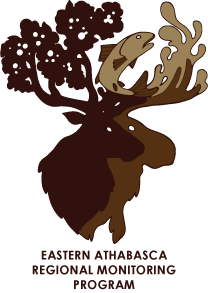Study Design and Objectives
The EARMP community program was developed to address potential concerns about the safety of traditional foods that community members routinely consume. Traditional foods can be defined as “native foods that are obtained from the land, such as wild game, birds, fish, and berries by local residents during subsistence hunting and gathering” (Peace Athabasca Delta Group Project 1972).
The key objectives are to:
Determine the safety of traditionally harvested food for local consumption through sampling and analytical testing.
Establish long-term monitoring at community harvesting areas to assess variability and potential changes over time.
To foster confidence in the consumption of traditional foods and food safety, as well as engage and involve community members in the gathering of information for the program.
Communicate monitoring results to community members and others through reporting, meetings, and public media.
Study Areas
There are seven communities in the Athabasca Region:
Black Lake Denesuline First Nation,
Fond du Lac Denesuline First Nation,
Stony Rapids,
Wollaston Lake,
Hatchet Lake Denesuline First Nation,
Camsell Portage, and
Uranium City.
The communities of Wollaston Lake and Hatchet Lake Denesuline First Nation are assessed together for a total of six community study areas for the program.
The community-based monitoring results are compared to baseline and regional reference data. The program is completed annually with the focus of the sampling campaign alternating to different traditional foods over a three year cycle. The community sampling program focuses on collecting water and fish, but also samples berries, mammals (moose and caribou) and bird chemistry. The focus of the 2019/2020 community program will be on water, berries, and fish chemistry with an additional allotment of supplemental samples from community members when available.
Community Involvement
Community members conduct the sample collections and help to select the sampling locations. The program depends on their participation and would not be possible without it. The selected representatives from each community were provided training in sample collection, storage, and shipping procedures. The sampling locations within each community were established during the field training session when physical variables such as water depth, important fishing locations, and important harvesting locations were determined.
The collection of the traditional food samples are carried out independently by the community members or in conjunction with a representative of Canada North Environmental Services (CanNorth), the consultant selected to manage the program.
Community Communications
Sharing the monitoring results is one of the primary goals of the EARMP community program. In addition to this website and its Reports (link) page, the following engagement strategies help to spread awareness and the results of the program:
Free EARMP calendars (link to PDF copy) in English, Cree, and Dene languages are distributed to the Athabasca communities and other northern communities once a year via band offices, community health centers, post offices, and schools.
Ads in Opportunity North magazine that include information about the program as well as contact information for those who have any questions or concerns.
Annual presentation of results to the Northern Saskatchewan Environmental Quality Committee (NSEQC) in La Ronge, SK.
Social media:
o https://www.instagram.com/cannorth_/
o https://www.facebook.com/CanNorthEnviroServices/
o https://www.linkedin.com/company/3094916/
Over the years, additional engagement activities have included the sponsorship of the Science Ambassador School Program (SASP) through the University of Saskatchewan with schools in the Athabasca Region. The SASP pairs senior university science, engineering, and health science students with rural and remote Aboriginal community schools to support creative and culturally-relevant science teaching and learning.
Go to Reports for full-length copies of all previous reports, which include results.
Peace Athabasca Delta Group Project. 1972. The Peace-Athabasca Delta - A Canadian resource, summary report. Edmonton Queen’s Printer, Province of Alberta.










